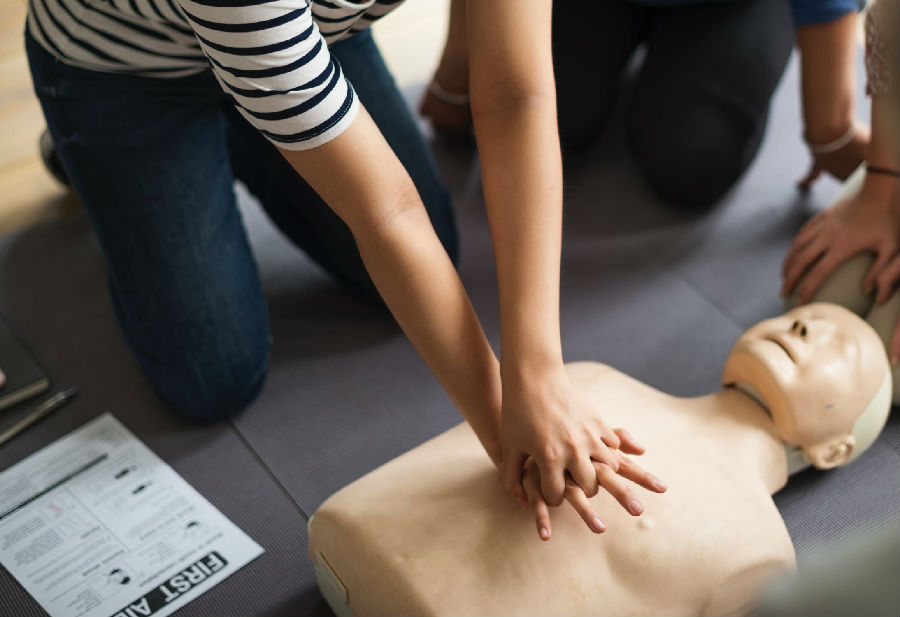Learning how to save lives with CPR
心肺復(fù)蘇納入中小學(xué)教育內(nèi)容
If you see someone collapse, perhaps as a result of a heart attack, what can you do while you wait for an ambulance?
如果你看到有人可能因為心臟病突發(fā)而失去意識倒地,在等待救護車到來時,你能做些什么呢?
Chen Wenqiaochu set a good example when he was 14. He performed CPR on a cleaner at his school, saving the man's life in 2013.
當(dāng)時只有14歲的陳文翹楚做了個好示范。2013年,他在校內(nèi)為一名清潔工實施了心肺復(fù)蘇,拯救了一條生命。
Chen showed that knowing how to perform CPR can be beneficial. According to medical experts, there is a "golden period", the first four minutes of a heart attack, when CPR is most effective in saving the person's life.
陳文翹楚的事跡表明,掌握心肺復(fù)蘇術(shù)大有用處。醫(yī)學(xué)專家認為,心臟病發(fā)作后的四分鐘是搶救的“黃金期”,在此期間實施心肺復(fù)蘇最有可能挽救生命。
On Aug 24, a joint guideline was issued by the Ministry of Education and Red Cross Society of China. It asks all public schools nationwide to provide first-aid courses, including CPR training, as part of health education.
8月24日,教育部和中國紅十字會總會聯(lián)合印發(fā)通知,要求全國公立學(xué)校將急救課程,特別是將心肺復(fù)蘇納入學(xué)校健康教育內(nèi)容。
CPR is not hard to grasp. All that one needs to learn is how to observe and decide if a person is unconscious, where to press on the patient's chest, and how to blow air through the mouth and into the lungs.
想要掌握心肺復(fù)蘇并不難。你需要學(xué)會觀察確認患者是否失去意識,掌握如何按壓患者胸部,并進行人工呼吸。
Unfortunately, less than 1 percent of Chinese adults have mastered the skill of CPR, while many have never heard of it.
然而,我國掌握心肺復(fù)蘇術(shù)的成年人不到1%,許多人甚至都沒有聽說過這項技能。
A 2019 survey from the Development Research Center (DRC) of the State Council noted that although 64.6 percent of schools have opened health education courses, the teaching results are not satisfactory, according to China Youth Daily.
據(jù)《中國青年報》報道,國務(wù)院發(fā)展研究中心2019年的一項調(diào)查指出,盡管64.6%的學(xué)校開設(shè)了健康教育課程,但教學(xué)結(jié)果卻并不令人滿意。

Zhao Shengyu, 18, a graduate from a Shandong high school, recalled her first time to be taught CPR in the class. "No model, video or practice was included. I realized the acts I had been taught orally had lots of errors after I was trained another time in a medical school," she said. Based on her own experience, Zhao said more qualified first-aid courses in schools are necessary.
山東某高中的18歲畢業(yè)生趙聲語(音譯)回憶起了她第一次上心肺復(fù)蘇課程的情景。“沒有模型、視頻或者練習(xí)。直到我某次在一所醫(yī)學(xué)院培訓(xùn)時才發(fā)現(xiàn),先前口頭教授的動作中錯誤百出,”她說道。基于她自身的經(jīng)歷,趙聲語認為有必要提高課堂急救培訓(xùn)的質(zhì)量。
Ding Banghan, a doctor from Guangdong Provincial Hospital of Chinese Medicine, is a strong supporter for bringing first-aid knowledge into the classroom. "The first-aid course in schools is key for its popularization," said Ding, according to Guangzhou Daily.
廣東省中醫(yī)院醫(yī)生丁邦晗大力支持急救知識走進課堂。據(jù)《廣州日報》報道,丁醫(yī)生表示:“校內(nèi)的急救課程是普及的關(guān)鍵。”
Many countries have attached importance to the popularization of first-aid training, including CPR.
許多國家都十分重視包括心肺復(fù)蘇術(shù)在內(nèi)的急救知識普及。
In 1966, the American Heart Association stipulated that US police officers, firefighters, secondary school teachers and college instructors must receive CPR training. And a 2017 survey showed that 65 percent of Americans had received CPR training.
1966年,美國心臟協(xié)會規(guī)定,全美警察、消防員、中學(xué)以及大學(xué)教師都必須接受心肺復(fù)蘇培訓(xùn)。而2017年的一項調(diào)查顯示,65%的美國人都曾接受過心肺復(fù)蘇培訓(xùn)。
In Switzerland, all citizens are asked to be trained in first aid, including CPR. In Germany, every citizen must be trained before getting their driver's license, which means about 80 percent of the country has received first-aid training. Forty percent of people in France are also trained in first aid, according to CGTN.
瑞士要求全民接受包括心肺復(fù)蘇在內(nèi)的急救培訓(xùn)。而在德國,公民在獲得駕照之前必須接受急救相關(guān)培訓(xùn),這意味著該國約有80%的人接受過急救訓(xùn)練。據(jù)中國國際電視臺報道,40%的法國人也接受過急救訓(xùn)練。













